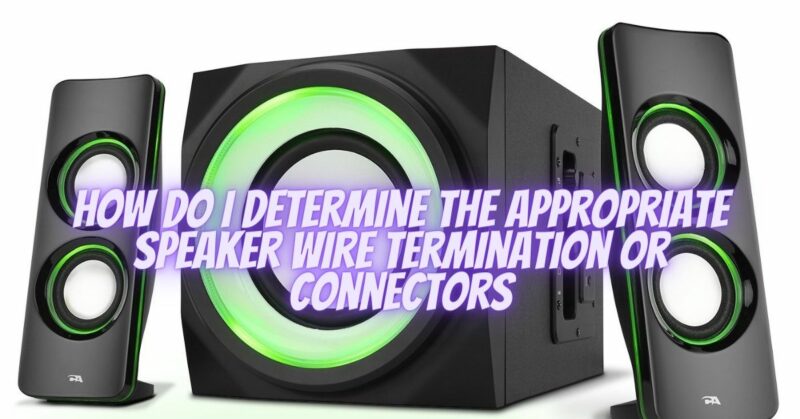When setting up a speaker system, choosing the appropriate termination or connectors for your speaker wires is crucial to ensure reliable signal transmission and optimal audio performance. The right termination method not only ensures a secure and stable connection but also minimizes signal loss and interference. In this article, we will guide you through the process of determining the appropriate speaker wire termination or connectors, allowing you to make informed decisions when setting up your audio system.
- Consider the Speaker Wire Type:
Before selecting the termination method, it’s essential to consider the type of speaker wire you are using. Speaker wires come in various gauges (thickness) and materials, such as copper or oxygen-free copper (OFC). Ensure that the termination method is compatible with your specific speaker wire type to maintain signal integrity and prevent compatibility issues.
- Evaluate Connection Options:
There are several termination options available for speaker wires. Each option has its advantages and considerations:
a. Bare Wire: This is the most basic and straightforward termination method. It involves stripping the insulation from the wire ends and directly connecting them to the binding posts or terminals on the speakers and amplifiers. While bare wire connections are simple and cost-effective, they may be prone to accidental short circuits and can potentially lead to signal degradation if the exposed wires come into contact with other conductive materials.
b. Banana Plugs: Banana plugs provide a convenient and secure termination option. These connectors feature a banana-shaped pin that fits into the binding posts or terminals. Banana plugs offer easy insertion and removal, ensuring a reliable connection and minimizing the risk of short circuits. They are particularly suitable for binding posts that have small holes or those that do not accept bare wire connections.
c. Spade Connectors: Spade connectors, also known as fork terminals, feature a flat metal or plastic piece with a hole that can be inserted under the binding post or terminal. Spade connectors offer a more secure connection than bare wire and are particularly beneficial for heavier gauge wires. They provide excellent contact and can handle higher power levels.
d. Pin Connectors: Pin connectors consist of a metal pin that is inserted into the binding post or terminal. They offer a reliable and easy-to-use termination method, ensuring a solid connection. Pin connectors are available in various sizes, allowing compatibility with different binding post configurations.
e. Twist-Lock Connectors: Twist-lock connectors combine the convenience of banana plugs with a locking mechanism for added security. These connectors feature a threaded sleeve that screws onto the binding posts, ensuring a tight and secure connection. Twist-lock connectors are ideal for high-power applications or situations where the speakers may experience movement or vibrations.
- Consider System Compatibility:
When selecting the termination method, ensure compatibility with your audio system components, including speakers, amplifiers, and receivers. Some components may have specific binding post designs or accept only certain termination options. Verify the specifications and recommendations provided by the manufacturer to ensure the chosen termination method aligns with your equipment.
- Quality and Durability:
Opt for termination options that offer reliable build quality and durability. High-quality connectors with solid construction materials provide better contact, reduce signal loss, and resist corrosion over time. Look for connectors with gold or silver plating, as these materials enhance conductivity and prevent oxidation.
Conclusion:
Determining the appropriate speaker wire termination or connectors is essential for establishing a reliable and high-performance audio system. Consider the type of speaker wire, evaluate various termination options (such as bare wire, banana plugs, spade connectors, pin connectors, or twist-lock connectors), and ensure compatibility with your audio system components. By making informed decisions and selecting quality termination methods, you can achieve secure connections, minimize signal loss, and enjoy optimal audio performance from your speaker system.

